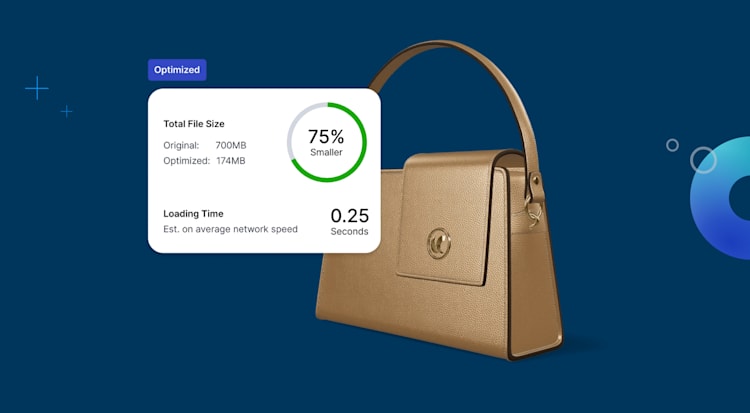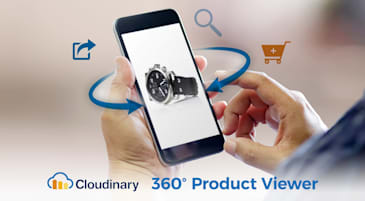E-commerce brands face challenges that can make or break their market position. Challenges include:
- Standing out from the competition. There are over 26.5 million e-commerce businesses in the world, a nearly 300% growth from 2019 to 2023. Businesses must compete against peers, giant retailers, and larger brands that have more resources. (Amazon alone is responsible for 36.7% of all e-commerce sales.) Mid-market e-commerce brands need to up the ante to catch potential consumers’ attention, One way to do that is to upgrade product presentations.
- Displaying high-quality product presentations on a budget.: Maximizing sales on a limited budget is always top-of-mind for mid-market e-commerce businesses. Because product presentation directly impacts sales, the pressure to consistently produce high-quality content without breaking the bank, at scale, is immense.
- Providing excellent customer experiences. Today’s consumers have high expectations for their online shopping experience. At a minimum, they demand intuitive navigation, fast loading times, detailed product information, accurate and engaging product representation, and seamless transaction processes. The consequences are direct: 88% of users will never return to a site after a bad experience, and 61% of consumers are willing to pay more for a good customer experience.
- Converting visitors to buyer. The global average conversion rate for e-commerce is around 3%, and that’s the result of stellar product presentation, user experience, pricing strategy, and trust signals. To top it all off, 2024 is seeing all-time high rates of cart abandonment across the industry.
While varying in magnitude and priority, there’s one factor that e-commerce brands can upgrade to get them ahead: superior product presentation. High-quality, interactive visual representations of your products provide outstanding customer experience, and increase conversion rates (by up to 86%). And it can be done without breaking the bank by transforming 3D models into a multitude of engaging visuals.
A Cloudinary survey has shown that online shoppers are more likely to buy if they have access to helpful media such as 3D models (53%) and 360-degree spin sets (57%). According to Shopify, 3D or 360-degree product images can increase conversions by up to 250%.
Here are four ways your 3D models can be transformed into stunning 3D and 2D product presentations.

A 3D product configurator displays products with numerous variations in an easy-to-use, interactive format. Customers can then customize products according to their preferences, such as changing colors, materials, or textures, engage with the product, and visualize their preferences in real time.
- Increased customer engagement. Eighty-eight percent of online shoppers are more likely to stay engaged and continue shopping as a result of a customizable experience.
- Higher conversion rates. Customization options can lead to longer session times, which indicates a higher likelihood of conversion.
A 3D viewer on your product pages lets customers interact with your products in a virtual space. They can rotate, zoom, and explore the product in detail from every angle, giving them a better understanding of the product’s features and appearance.
- Improved product understanding. Eliminates doubts regarding product appearance and specifications, leading to a 40% decrease in returns.
- Enhanced user experience. Adds a layer of interactivity and sophistication to your e-commerce site.
- Integration with AR. Some 3D viewers are compatible with augmented reality (AR), allowing customers to visualize the products in their own space. Shoppers, especially Gen Z shoppers, are more inclined to buy from brands that provide an AR experience.
3D modeling extends into the realm of dynamic content through high-quality videos, including camera flyovers. These videos can simulate a camera moving around or through the product, providing a cinematic-quality experience.
- Purchasing decision. Eighty percent of online consumers feel more confident in purchasing a product after watching a product video.
- Engaging experience. Create an immersive experience that can captivate potential customers and hold their attention.
- Shareable content. High-quality 3D videos are more likely to be shared on social media, increasing product and brand visibility (68% of consumers include social media in their purchasing decisions).

The most direct and traditional application of 3D models is the creation of high-quality images. Two out of 3 online shoppers are more convinced to purchase by high-definition visuals than product descriptions, and 30% of Cloudinary’s survey respondents said that they’ve returned a product because it wasn’t what they saw on the website.
Unlike static images, 3D-rendered images can be adjusted and reconfigured to highlight specific product features, demonstrate functionality, or convey a particular lifestyle appeal without the need for physical prototypes or expensive photoshoots.
- Enhanced product presentation. High-resolution images rendered from 3D models can be easily modified into numerous variants.
- Cost-effective. Save on the costs associated with product photoshoots.
- Faster time-to-market. Get products online faster by rendering your visuals from 3D models, rather than waiting on a photoshoot and multiple rounds of edits.
- Flexibility. Quickly update or modify images to reflect product changes, seasonal themes, or marketing campaigns without needing new prototypes and photoshoots.
Integrating 3D model transformations into your e-commerce storefront isn’t just about keeping up with technological advancements; it’s about strategically leveraging engaging experiences to solve core business challenges. By transforming 3D models into product configurators, 3D viewers, immersive videos, and high-quality images, e-commerce businesses can significantly improve their customer experience, conversion rates, and market competitiveness.
With Dimensions, you can transform any 3D model into stunning 3D creatives and visual experiences, such as product configurators, 3D viewers, videos, images, and more, in just a few clicks and at scale across your entire product catalog. Dimensions makes 3D accessible to all team members (not just 3D professionals) with a developer-ready platform and a user interface for content and creative managers.
To start, upload your 3D model, generate the assets you’d like using one of our templates, and integrate them to your website using URL, JS snippet, or the API.



